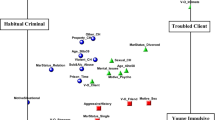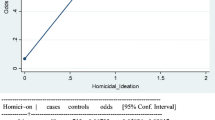Abstract
A nonrandom national U.S. sample of 946 homicide crime scenes--supplied by the FBI Behavioral Science Unit for purposes of research--was studied to delineate the prevalence, types, levels, and motives for staging in domestic, nonserial sexual, serial sexual, and general felony homicides. Stagers were found to be a relatively small group who employ a variety of methods to alter the crime scene in an attempt to redirect the investigation away from themselves as logical suspects. Results also suggest that different types of homicides have different staging rates based primarily on the relationship (or connection) between offender and victim. Implications for investigations and understanding this type of crime scene behavior are discussed.
Similar content being viewed by others
References
Adair TW (2002) The reconstruction of a staged sexual assault. J Forensic Ident 52:137–143
Dietz PE, Hazelwood RR (1982) Atypical autoerotic fatalities. Med and Law 1:301–319
Douglas JE, Burgess AW, Burgess AG, Ressler RK (1992) Crime Classification Manual. Jossey-Bass, San Francisco
Douglas JE, Munn C (1992) Violent crime scene analysis: Modus operandi, signature, and staging. FBI Law Enfor Bull 61:1–10
Geberth VJ (1983) Practical homicide investigation. Elseiver, New York
Geberth VJ (1996) The staged crime scene. Law and Order 44:1–7
Geberth VJ (2003) Sex-related homicide and death investigation. CRC Press, Boca Raton, FL
Geberth VJ (2010) Frequency of body posing in homicides. Law and Order 58:29–31
Gross H (1907) Criminal investigation. Lawyers Cooperative Printing Co., New York
Hazelwood RR, Dietz PE, Burgess AW (1983) Autoerotic fatalities. Heath, Lexington, MA
Hazelwood RR, Napier N (2004) Crime scene staging and its detection. Int J Offender Ther Compar Crim 48:744–759
Hazelwood RR, Warren J (1995) The relevance of fantasy in serial sexual crime investigation. In: Hazelwood RR, Burgess AW (eds) Practical aspects of rape investigation, 2nd edn. CRC Press, Boca Raton, FL, pp 127–138
Hoffman W, Headley L (1992) Contract killers. Thunder's Mouth Press, New York
Keppel RD, Weis JG (2004) The rarity of "unusual" disposition of victim bodies: Staging and posing. J Forensic Sci 49:1308–1312
Meloy JR (2000) The nature and dynamics of sexual homicide: An integrative review. Aggress Violent Beh 5:1–22
Meloy JR (2001) Spousal homicide and the subsequent staging of a sexual homicide at a distant location. J Forensic Sci 47:395–398
Morton RJ, Hilts MS (eds) (2008) Sexual murder: Multidisciplinary perspective for investigators, F.B.I., U.S. Department of Justice, Washington, D.C.
O'Connell J, Soderman H (1936) Modern criminal investigation. Funk & Wagnalls, New York
Ressler RK, Burgess AW, Douglas JE (1988) Sexual homicide: Patterns and motives. Free Press, New York
Safarik ME, Jarvis J, Nussbaum K (2000) Elderly female serial sexual homicide. Homicide Stud 4:294–307
Saferstein, R. (2011). Criminalistics: An introduction to forensic science (10th ed.), Prentice Hall, Upper Saddle River, New Jersey.
Schlesinger LB (2001) The contract murderer: Patterns, characteristics, and dynamics. J Forensic Sci 46:1119–1123
Schlesinger LB, Kassen M, Mesa VB, Pinizzotto AJ (2010) Ritual and signature in serial sexual homicide. J Am Acad Psychiatry and Law 38:239–246
Svensson A, Wendel O (1974) Techniques of crime scene investigation, 2nd edn. Elsevier, New York
Turvey BE (2000) Staged crime scenes: A preliminary study of 25 cases. J Beh Profiling 1:1–14
Warren J, Hazelwood RR, Dietz PE (1996) The sexually sadistic killer. J Forensic Sci 41:970–974
U.S. Department of Justice (2010). Crime in the United States: F.B.I Uniform Crime Reports, Washington, D.C.
Acknowledgements
The authors would like to express their gratitude to the FBI's Behavioral Science Unit for coordinating access to the data used in this study. The authors' opinions, statements, and conclusions should not be considered an endorsement by the FBI or the Department of Justice of any policy, program, or service.
Author information
Authors and Affiliations
Corresponding author
Appendix
Appendix
Examples of Observed Staging Methods
Verbal
A husband killed his wife while she slept by smashing her head. He dismembered her, buried some of the body parts, and threw the remaining body parts in a dumpster. The offender then contacted the police and said his wife had been missing for the past two weeks.
Accident
A woman severely beat her mother to death. She washed the body, changed the victim’s clothes, and placed the body at the bottom of the staircase to make it appear as if her mother accidentally fell down the stairs.
Burglary
An adult female was killed by her boyfriend. She died of numerous stab wounds and her throat was cut. The boyfriend called the police and said he came home, found the apartment burglarized with valuables taken, and his girlfriend was also killed by the intruders. The offender had purchased gasoline with cash, and specifically asked for a receipt, in an effort to prove he was elsewhere at the time of the homicide.
Arson
A mother stabbed to death her two young children out of anger. She then set the house on fire, using matches to light several blankets.
Suicide
A man shot his girlfriend in the head after she laughed at him during target practice. He placed a gun in the victim’s hand, pointed at her head, to make it appear as if she shot herself.
Homicide/Suicide
An adult male shot his father and brother. The brother was shot four times in the head, the father was shot in the head once. The offender put the gun in the father’s hand and told the police that he thought the father had shot his brother and then committed suicide.
Non-sexual Homicide
A husband shot and killed his wife. He then lured a man to his home by asking him for a ride to the airport. The husband then shot and killed the would-be driver. He told the police the driver shot his wife and he was forced to shoot the driver after he took the gun from him.
Sexual Homicide
A husband killed his wife by suffocation with a pillow. He unbuttoned, unzipped, and pulled down her pants, exposing her underwear. He also lifted up her shirt and removed her bra. She had not been sexually assaulted.
Attempted/Failed
A man killed an elderly woman who was selling drugs and alcohol. He robbed her, cut her neck with a knife, and stabbed her with a screwdriver. The offender then turned on the gas and unsuccessfully tried to set a fire. A welfare worker came upon the scene and called the police.
Unclassified-Other
An older man got into an argument with a much younger man who was his live-in companion. He shot and killed the young man, then shot into the ceiling and in the wall where he said he was seated. He told police the young man shot at him, and he was forced to shoot the victim in self defense.
Rights and permissions
About this article
Cite this article
Schlesinger, L.B., Gardenier, A., Jarvis, J. et al. Crime Scene Staging in Homicide. J Police Crim Psych 29, 44–51 (2014). https://doi.org/10.1007/s11896-012-9114-6
Published:
Issue Date:
DOI: https://doi.org/10.1007/s11896-012-9114-6




